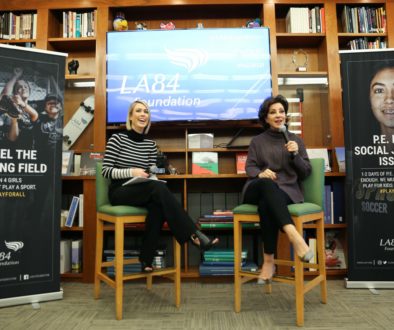SL Interview: Dr. Robert Cantu Speaks Out About Concussions in Youth Sports
Dr. Robert Cantu is one of the world’s foremost authorities on concussions and brain trauma in sports, with a lengthy resume. He earned his undergraduate degree at the University of California, Berkeley, where he pitched on the baseball team, and then his medical degree at the University of California Medical School in San Francisco. Currently, he is the chief of neurosurgery as well as the director of the Service of Sports Medicine at Emerson Hospital in Concord, Mass. He is the co-director of the Center for the Study of Traumatic Encephalopathy at Boston University, which is investigating the link between concussions and progressive brain disease. He consults with numerous NFL, NHL, and NBA teams.
Along with journalist Mark Hyman, Dr. Cantu has authored a new book titled “Concussions and Our Kids: America’s Leading Expert on How to Protect Young Athletes and Keep Sports Safe” (Houghton Mifflin Harcourt). The book defines what a concussion is, examines the causes and symptoms of concussions among youth athletes, explains why complete cognitive and physical rest is the best therapy for post-concussion syndrome, and provides easy-to-follow guidelines for parents and coaches to use in protecting their youth athletes.
Part polemic and part prescription, the book discusses the dangers in contact and non-contact youth sports, including soccer, ice hockey, lacrosse, volleyball, wrestling, boxing, mixed martial arts, basketball, baseball and softball, tennis, skateboarding and cheerleading. Perhaps not surprisingly, the authors identify football at the youth level as “the greatest challenge by far. Children are among the most vulnerable to injury because they have weak necks and immature musculature, and their brains are still developing. And youth football by far accounts for the largest number of players — almost three million from ages six to fourteen, according to USA Football.”
SportsLetter recently spoke with Dr. Cantu over the phone from his office.
— David Davis
SportsLetter: You co-authored this book with Mark Hyman. What was it like to work with a “lay person” on this project?
Robert Cantu: It was a great experience. I’ve written 30 books, but they’ve mostly been medical books. They’re boring to read. Mark is excellent at his craft. He takes my compound sentences and breaks them up into four or five short, peppy, perfect ones. Even I like to read what he comes up with.
SL: Was it difficult for you to write a book that wasn’t exclusively for the medical community?
RC: I’ve done a couple of “lay” books, including on diabetes and exercise and fitness, where we didn’t have any of the normal footnoting and referencing you do for medical journals and such. Here, we were trying to speak to a different audience — not necessarily the medical community, but parents and coaches and kids. It was really easy to do this because anything I didn’t do right, Mark made right.
SL: How did you get interested in the issue of concussions in sports?
RC: As a neurosurgeon and as a person who was an athlete in school and continues to be involved in athletics, the natural thing for me to be involved with sports medicine-wise would be head and spine injuries. That’s what we’ve researched and followed, and that has been our major area of interest for about 40 of the 45 years I’ve been in neurosurgery.
SL: When did you first realize that concussions in youth sports were becoming a major problem?
RC: When I was a sideline physician for a high school football team over 30 years ago. That’s when it occurred to me that we needed some written guidelines for returning our young athletes to the field of play after they suffered a head injury. That’s what led me to write the first Return to Play Guidelines back in 1986.
I’m a strong supporter of youth sports, but no head trauma is good head trauma. You cannot condition the brain to taking blows. If you subject the brain to enough head trauma, permanent brain damage may happen.
SL: In your experience, has the number of concussions among youth athletes been on the rise or is the reporting of concussions among youth athletes on the rise?
RC: I think it’s primarily the latter. Clearly, the great majority of mild concussions even today go unrecognized. But fewer of them go unrecognized today because of the better education of the medical team that’s taking care of them and the better recognition on the part of coaches, parents, and the athletes themselves about what concussion symptoms are. Where it was very, very common for athletes to be stunned or dinged or seeing stars and keep playing 20 years ago, 10 years ago, even five years ago, it’s less common today that that happens. It still happens, and there’s lots of room for improvement still, but it’s a lot better than it used to be.
SL: Why did so many sports-related concussions among youth go unrecognized or unreported for so long?
RC: The reasons that the athletes gave themselves when asked were primarily a) they didn’t know what concussion symptoms were and b) they didn’t know it was a serious deal. Concussions were treated like a sprained ankle. To a lesser extent, it’s the culture of the sport — you know, “suck it up,” “be tough.” The athletes didn’t want to let down their teammates and, to a lesser extent, they didn’t want to lose their position for fear that someone else might take their place.
SL: In your practice today, what are the most common myths — the most common misconceptions — about concussions among youth athletes? Is it that there has to be a contact sport involved?
RC: I think the number-one most serious misconception is that you have to be rendered unconscious to have suffered a concussion. More than 90 percent of athletic concussions occur without any loss of consciousness. There are 26 symptoms associated with concussions, and loss of consciousness is only one of those.
Another very common myth is that concussions become exponentially worse as you accumulate them, so that your first one will be more mild than your second, and your third will be worse than your second one. That’s just not reality. The concussions happen to be whatever they are based on the forces involved. I’ve seen many individuals whose first concussion was much more severe than subsequent ones.
SL: How is a concussion involving a youth athlete different than a concussion involving an adult athlete?
RC: Generally speaking, the young athlete will have symptoms that can be imparted with forces that are much less than the adult athlete deals with. And, the symptoms for the average youth will last a bit longer than for an adult. That’s related to the fact that youth brains are particularly vulnerable. Youth brains do not have myelin coating of the axons, which gives the axons greater strength in adults that do have that coating. They’re also more susceptible to what we call the “neurometabolic cascade of concussion” — during which time chemicals are released in the brain in a disorderly fashion.
SL: Are children more, or less, vulnerable to concussions and head trauma than adults? If so, why?
RC: Youngsters have big heads and weak necks, and that bobblehead-doll setup puts them at much greater risk for concussion. That’s especially true through ages five to eight. Simply put, youth can’t brace their necks like adults can in a collision. That’s a huge reason why anyone playing a contact or collision sport — at any age — should be strengthening their neck muscles.
SL: Do children recover differently from concussions than adults?
RC: As a group, youth recover a bit slower than adults. Because the youngsters’ brain is evolving and growing, often it’s very difficult to measure insults to youngsters as easily as we can measure them in adults. You can give adults more complex intellectual challenges than you can give to youngsters and thus more readily measure their progress.
SL: How do you resolve that so that you can more accurately measure the recovery of youngsters from concussion?
RC: There are individuals, like Dr. Gerry Gioia, in Washington, D.C., who are working to modify the neurospsychological tests we give specifically for youngsters. This would be used for young ages, under the age of 10.
For instance, one of the common questions that we ask adults in the post-concussion checklist is, “Do you feel like you’re in a fog?” To a youngster age 5 or 6, that might mean that they can’t see so well. Whereas, what we’re really getting at is, “Are you mentally not clear?” So, in place of certain words, children are asked to identify certain objects. We don’t get into vocabulary issues.
SL: How about if a youth athlete suffers multiple concussions: how does that affect his or her brain development?
RC: The potential to have greater affect is there, but we can’t really quantify it exactly. We know that the risk is greater and that the forces needed to produce injury are less. And, unfortunately, if we’re going to wind up with neuro-degenerative problems because of repetitive brain trauma — and not just at the concussion level, but also at the sub-concussion level – the earlier we start accumulating that trauma, the more likely we are to have more of it by the time we get to be an adult.
SL: In your opinion, what is the biggest mystery about concussion among youth athletes: is it the duration of post-concussion syndrome for certain kids or is it figuring out why certain youth are more vulnerable to concussions than others?
RC: The number-one thing would be to have one diagnostic test that is easy to administer and sensitive for concussion. We are studying this. I believe that we will have, within the next five or so years, imaging modalities — probably MRI or a variant of MRI — and/or bio-markers that will be very sensitive as to when a concussion has happened and when a concussion has cleared and it’s safe to allow that individual to go back to sports.
Right now we don’t have that. You can’t see abnormalities on any imaging studies that are routine, and there are no bio-markers currently sensitive and specific enough for a concussion to be determined. Right now, the diagnosis of concussion is clearly a clinical one based on the checklist and based on the neurologic examination.
SL: There are some tackle football leagues that now involve youngsters as early as age 5. How would you advise parents whose son wants to play football: Is there a “safe age” for tackle football?
RC: I don’t think parents should bring their kids into tackle football short of high school. And, if their kid is not well developed and doesn’t have secondary sex characteristics — like hair under their arms and so forth — then I’d say wait until their child is 16 or until they do.
The bottom line is, head trauma can come from tackle football at any age. We now know that, very occasionally, youngsters sustain g-forces equal to those at the high school and college level. To me, it’s not appropriate that we’re subjecting their brains to that kind of trauma when the alternative is playing the sport anyway, through flag football, and still learning the skills of tackle football, but practicing those skills on pads and dummies and not getting hit.
The same principal applies to other sports. They should ban heading the ball in soccer below a certain age and ban body checking in youth hockey until the age of 14.
SL: What do you think of the tackling techniques developed by Train ‘Em Up Academy, supported by USA Football, which teaches kids how to tackle with their heads up, not down, and to avoid head-first tackling?
RC: I think it’s great. I’m 100 percent behind it. I’m 100 percent behind reducing the amount of tackling and full contact that goes on in practice. That’s where the majority of the hits can be eliminated because that’s where the majority of them happen. Having said that, I think that for these young ages, the right thing to do is to not do the activity itself.
There are people who argue that you have to start your kid at the earliest age possible — with the best of trainers and the best of coaches and the best of equipment — if they’re ever going to reach the elite level. That’s nonsense. They are going to be much better at a young age, at least compared to someone who doesn’t receive that sort of training, but when they get to the college age, it’s essentially the genetic makeup that’s going to determine whether or not they’re going to play at the elite level.
I use [New England Patriots quarterback] Tom Brady as an example about this. His dad kept him out of tackle football until he was in high school. It hasn’t seemed to hurt his career too much.
SL: In the book, you discuss several safety recommendations for youth athletes. What are key recommendations that you advocate for protecting young athletes from the dangers of head trauma?
RC: I think that every high school should have a certified athletic trainer. If they don’t have one, the high school should seriously consider whether they should be competing in collision sports. I know that many schools are facing financial challenges, but they might be able to have that trainer be a teacher and teach physical education or some other subject.
SL: What about improved helmet design and/or technology?
RC: Today’s helmets do a marvelous job of protecting against skull fracture. That’s something we almost never see anymore in our practice. And, helmets reduce the most serious inter-cranial bleeding — they’ve reduced that dramatically, by almost 80 percent. But they don’t do very much for protecting against concussion. That’s because the most injurious acceleration the brain can get is a rotational one, where the head is spun violently. The helmets don’t do very much at all about attenuating those forces. I’m totally in favor of better helmets, but unfortunately I don’t believe that helmets are the solution in terms of concussion.
SL: In the book, you write that many states have adopted legislation to educate coaches and trainers about concussions. Do you think that all states need to adopt such laws?
RC: Such laws can help immensely. I’m thrilled that more than 30 states have some form of this legislation [also known as Lystedt Law, named after a youngster who suffered second impact syndrome]. All of the laws have various forms of three parts: one is education, required for the coaches, the parents and the athletes themselves; two is the mandate that if an athlete is suspected of having a concussion or is diagnosed with one, that athlete is immediately removed from practice or play; and the third element is that they can only be cleared to return to practice not by a coach or a parent but by someone with concussion education and experience.
SL: What is the coach’s responsibility regarding youth athletes and concussion and what is the parents’ responsibility about their children and concussion?
RC: I think there has to be education — and we have to able to demonstrate that the people have absorbed the messages. It’s vital that coaches and parents understand that an individual who is symptomatic from a concussion needs physical and cognitive rest. To subject them to more trauma is asking for post-concussion syndrome and, in a very small number of instances, second impact syndrome, which has a very high incidence of death.
SL: Why do you think there was so little done — or even discussed — about concussions even 10 years ago? Was it ignorance? Was it the culture of sports?
RC: I think it’s largely the fault of the medical profession because they didn’t point out the dangers of concussion. They kind of left it so that most people assumed that, after a concussion occurs, people completely recover from them and there are no long-term consequences.
Unfortunately, we now know that not only are there long-term consequences for some people, with later-life issues that can be devastating, but there are individuals that have to deal with months of post-concussion symptoms and, in certain cases, years of post-concussion symptoms.
SL: Has the debate over concussions in the NFL — including the lawsuits and the very public suicides of retired players — opened up discussion about concussions at the youth level of sports?
RC: I look at the NFL as not having taken many steps about concussion prior to 2010. Since 2010, the NFL has been the leading league in this country, professional and/or amateur, in doing pro-active things to reduce head trauma among the players. They’ve incorporated many rules changes and, within the past few weeks, they donated $30 million to support National Institutes of Health research in the area of athletic head trauma.
SL: By contrast, you note that the NHL has been less than pro-active in dealing with concussions. What steps should the NHL take?
RC: In my mind, the NHL should do two things: one, outlaw all intentional checks to the head. Just make hitting to the head illegal. And, two, if the NHL really cares about the health of their athletes, as well as their brains, the NHL can’t allow bare-knuckle street fighting on the ice. That is just insane.
SL: In the book, you don’t advocate the banning of boxing. Why do you feel that way?
RC: I don’t support boxing for anybody at any age — youth or adult. I don’t support hitting somebody else’s head and I don’t support letting your head get hit. I support box-aerobics for adults, and I support going through the motions of fighting — hitting bags and exercising — because the exercise is marvelous. It’s using the entire body, and it’s a great cardiovascular workout.
I don’t advocate boxing for youngsters. If you have other options, take them. But the overwhelming majority of youngsters involved with boxing are inner-city and/or disadvantaged youth who don’t have options like golf courses and tennis courts to go to. These kids are much, much more at risk being on the street than they are being in a gym under supervision. That gym may give them the only structure they have in their life. I know of many individuals whose lives were turned around through the discipline they learned in boxing. So, whereas I don’t advocate boxing, I don’t come down and say, “Snuff it out.”
SL: There’s been a lot of talk about total head trauma and whether that leads to the brain disease called chronic traumatic encephalopathy. In your opinion, do multiple concussions lead to CTE?
RC: What we know about CTE today comes from our experience at the Center for the Study of Traumatic Encephalopathy at Boston University, which is the world’s largest brain bank currently, with over 100 brains having been studied. It’s total brain trauma that seems to wind up associated with CTE, and not just the number of concussions. We have individuals in the brain bank that never had a recognized concussion, and yet had CTE.
Now, whether they truly didn’t ever have a concussion, we don’t know. Nonetheless, what we see are that the athletes in the sports with the greatest amount of head trauma, and the athletes who play the positions within that sport that generate the greatest amount of head trauma, seem to be the ones with the greatest amount of CTE. In helmets, it’s the linemen and the linebackers who crash heads on every play; it’s not the wide receivers and the quarterbacks who might take a spectacular hit now and then.
SL: Where do you see the future of research involving CTE?
RC: I hope it’s headed in the same direction as concussion in the sense that we, among others, are studying the effects of CTE among high-risk populations of athletes. We are trying to see if we can come up with not only imaging technologies but also identifying bio-markers that are going to be specific and sensitive enough to diagnose CTE among living individuals so that we can start to look for therapies.
SL: Do you think that will happen soon?
RC: I’ll be very disappointed if, within the next five years, maybe sooner, we won’t be able to diagnose with near certainly CTE in living individuals. Right now, it’s a clinical diagnosis, and we can have a very high index of suspicion. But the proof is only after someone has died.
SL: Finally, what surprised you most in writing this book?
RC: What surprised me — and I’m thrilled about it — is that the changes are already being seen. In the National Football League, for instance, in the new collective bargaining agreement, the amount of full contact hitting that’s allowed has been reduced. In other words, players can only bang bodies 14 times [in full-contact, padded practices] during the 18-week season. I’d like to think that this happened because of my voice, among many others.
Already, that’s making the sport safer, and that has a trickle-down effect. They’re beginning to reduce contact in practices in youth football. In one college conference, the Ivy League, they’ve reduced hitting to two days a week. I think that, as the education and awareness of head trauma and concussion grows, this trend will continue so that all athletes, youth and adult, will be better protected.




